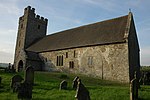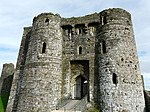Name LocationGrid Ref. [ note 1] Date Listed Function Notes Reference Number Image Church of St Margaret Marloes, Eglwyscummin Eglwyscummin 51°45′59″N 4°33′55″W / 51.766485359737°N 4.5651784716532°W / 51.766485359737; -4.5651784716532 (Church of St Margaret Marloes, Eglwyscummin ) 30 November 1966 Church Situated in a prominent position on the N side of the B4314, some 2.5km SE of Rhos-goch. [ 4] [ 5] 9389 See more images
Llansteffan Castle Llansteffan 51°45′56″N 4°23′26″W / 51.765673538851°N 4.3904680276349°W / 51.765673538851; -4.3904680276349 (Llansteffan Castle ) 30 November 1966 Castle Prominently situated on a rocky promontery, overlooking the mouth of the Tywi. [ 6] [ 7] 9405 See more images
St Peter's Church, Carmarthen Carmarthen 51°51′29″N 4°18′10″W / 51.858014060302°N 4.3026750809433°W / 51.858014060302; -4.3026750809433 (St Peter's Church, Carmarthen ) 18 August 1954 Church Situated in rounded churchyard at end of King Street. [ 8] [ 9] 9435 See more images
Carmarthen Castle Carmarthen 51°51′22″N 4°18′21″W / 51.856021331313°N 4.3056956078448°W / 51.856021331313; -4.3056956078448 (Carmarthen Castle ) 18 August 1954 Castle Situated behind buildings on E side of Nott's Square. [ 10] [ 11] 9507 See more images
Outer Gatehouse to Laugharne Castle Laugharne Township 51°46′12″N 4°27′44″W / 51.769996314861°N 4.4622874287369°W / 51.769996314861; -4.4622874287369 (Outer Gatehouse to Laugharne Castle ) 25 September 1986 Gatehouse At the bottom of the street near the Town Hall, reached by path in front of Castle House. [ 12] [ 13] 9652 See more images
Laugharne Castle Laugharne Township 51°46′11″N 4°27′43″W / 51.769623603298°N 4.462049709389°W / 51.769623603298; -4.462049709389 (Laugharne Castle ) 30 November 1966 Castle On an elevated coastal site near the Town Hall, reached by path in front of Castle House. [ 14] [ 15] 9653 See more images
Newcastle Emlyn Castle Newcastle Emlyn 52°02′21″N 4°27′48″W / 52.039128924761°N 4.4633503651072°W / 52.039128924761; -4.4633503651072 (Newcastle Emlyn Castle ) 5 August 1991 Castle Sited on a peninsula to W of the town. Pedestrian access from Castle Street. [ 16] [ 17] 9716 See more images
Church of St Michael, Cilycwm Cilycwm 52°02′41″N 3°49′09″W / 52.044611649089°N 3.8192098171757°W / 52.044611649089; -3.8192098171757 (Church of St Michael, Cilycwm ) 8 July 1966 Church Situated on E side of village street, in centre of village. [ 18] [ 19] 10906 See more images
Plas Taliaris Manordeilo and Salem 51°56′01″N 3°58′46″W / 51.93371443426°N 3.9795174176033°W / 51.93371443426; -3.9795174176033 (Plas Taliaris ) 8 July 1966 Hall Situated 2km NE of Salem. [ 20] [ 21] 10911 See more images
Dryslwyn Castle Llangathen 51°51′47″N 4°06′05″W / 51.863086444876°N 4.1013355233841°W / 51.863086444876; -4.1013355233841 (Dryslwyn Castle ) 8 July 1966 Castle On high ground overlooking the Tywi Valley, to the E of the B4297 and on the N side of the river. [ 22] [ 23] 10934 See more images
Church of St Michael, Myddfai Myddfai 51°57′22″N 3°47′16″W / 51.956163311575°N 3.7879016017424°W / 51.956163311575; -3.7879016017424 (Church of St Michael, Myddfai ) 8 July 1966 Church Situated in rounded churchyard in centre of the village. [ 24] [ 25] 10957 See more images
Dolauhirion Bridge Llandovery 52°00′34″N 3°48′19″W / 52.009481070973°N 3.8051949579892°W / 52.009481070973; -3.8051949579892 (Dolauhirion Bridge ) 8 March 1966 Bridge Situated some 1.5km north of Llandovery, carrying road to Cilycwm and Porthrhyd across River Tywi. [ 26] [ 27] 10964 See more images
Church of St Mary, Llandovery Llandovery 52°00′04″N 3°47′36″W / 52.001236071187°N 3.7934124878727°W / 52.001236071187; -3.7934124878727 (Church of St Mary, Llandovery ) 8 March 1966 Church Situated on small hill above the modern A483 in large churchyard. [ 28] [ 29] 10967 See more images
Dinefwr Castle Llandeilo 51°52′37″N 4°01′07″W / 51.876814284337°N 4.0184949735057°W / 51.876814284337; -4.0184949735057 (Dinefwr Castle ) 8 July 1966 Castle Situated on a rocky, wooded ridge above Afon Tywi. [ 30] [ 31] 11117 See more images
Kidwelly Castle Kidwelly 51°44′22″N 4°18′21″W / 51.739502562072°N 4.305709926741°W / 51.739502562072; -4.305709926741 (Kidwelly Castle ) 12 May 1963 Castle Situated on a bluff above W bank of Gwendraeth Fach, across river from modern town centre. [ 32] [ 33] 11876 See more images
Church of Saint Mary, Kidwelly Kidwelly 51°44′12″N 4°18′23″W / 51.736800754749°N 4.3063689606529°W / 51.736800754749; -4.3063689606529 (Church of Saint Mary, Kidwelly ) 12 May 1963 Church Situated in centre of Kidwelly in large walled churchyard. [ 34] [ 35] 11878 See more images
Llanelly House (2 Llanelli 51°41′00″N 4°09′41″W / 51.683385690127°N 4.1614288066676°W / 51.683385690127; -4.1614288066676 (Llanelly House (2 Bridge Street) ) 17 June 1966 House Situated on corner of Vaughan Street and Bridge Street, facing Parish Church. [ 36] [ 37] 11892 See more images
Llanelly House (4 Llanelli 51°41′00″N 4°09′41″W / 51.683387556025°N 4.1613276288578°W / 51.683387556025; -4.1613276288578 (Llanelly House (4 Bridge Street) ) 17 June 1966 House Situated on corner of Vaughan Street and Bridge Street, facing Parish Church. [ 38] [ 39] 11893 See more images
Llanelly House, rear Llanelli 51°41′00″N 4°09′41″W / 51.683258837302°N 4.1614806295338°W / 51.683258837302; -4.1614806295338 (Llanelly House, rear wing (20 Vaughan Street) ) 17 June 1966 House Situated on corner of Vaughan Street and Bridge Street, facing Parish Church. [ 40] [ 41] 11894
Llanelly House, rear Llanelli 51°41′00″N 4°09′41″W / 51.683321464011°N 4.1614980799895°W / 51.683321464011; -4.1614980799895 (Llanelly House, rear wing (22 Vaughan Street) ) 17 June 1966 House Situated on corner of Vaughan Street and Bridge Street, facing Parish Church. [ 42] [ 43] 11895 Upload Photo Llanelly House (24 Llanelli 51°41′00″N 4°09′41″W / 51.683375105962°N 4.1615151024159°W / 51.683375105962; -4.1615151024159 (Llanelly House (24 Vaughan Street) ) 17 June 1966 House Situated on corner of Vaughan Street and Bridge Street, facing Parish Church. [ 44] [ 45] 11896 Upload Photo Dolauhirion Bridge Cilycwm 52°00′34″N 3°48′18″W / 52.00950105493°N 3.8050646240583°W / 52.00950105493; -3.8050646240583 (Dolauhirion Bridge ) 8 March 1966 Bridge Situated some 1.5km north of Llandovery, carrying road to Cilycwm and Porthrhyd across River Tywi. [ 46] [ 47] 16996 See more images
Carreg Cennen Castle Dyffryn Cennen 51°51′16″N 3°56′07″W / 51.854503676338°N 3.9352338825242°W / 51.854503676338; -3.9352338825242 (Carreg Cennen Castle ) 24 November 1998 Castle Spectacularly set on a crag over the upper Cennen valley, approached from Carreg Cennen Farm, about 1.5 km E of Trap. [ 48] [ 49] 20923 See more images




















